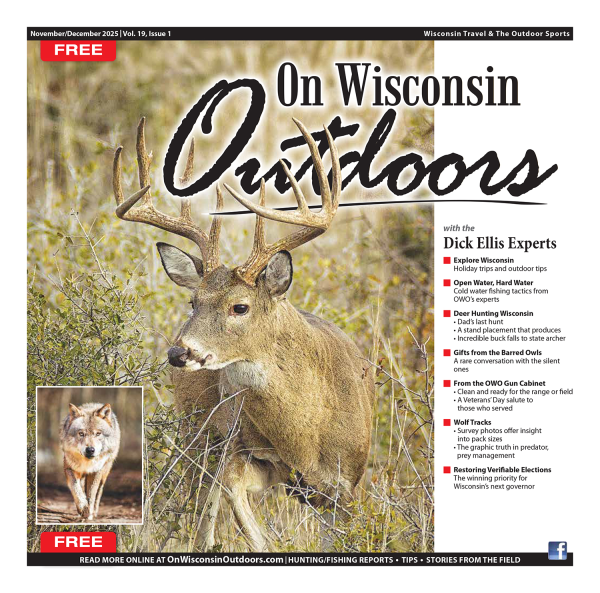IN MEMORY...Remembering huge snappers of yesteryear brings restricted season, protection
By Dick Ellis
Reader Note: “Dick’s Trips is a weekly column published from the On Wisconsin Archives and the Ellis field journeys over 25 years as a syndicated outdoor columnist. This column was written in 2003 in Dane County. The reader is responsible for knowing current trapping, fishing and hunting regulations. The 2012 turtle trapping season began July 15 and closes November 30.
Wading slowly through a visually stunning aquatic jungle of green lily pads and yellow flower blossoms, Rob Wegner finds good news ahead in the guide lines protruding above the water from the hoop-net funnel trap. The rope’s positioning tells Wegner that sometime since late afternoon the previous day, a snapping turtle has followed the aromatic slick created by a blend of trout and salmon scrap soaked in fish oil to this temporary mesh prison.
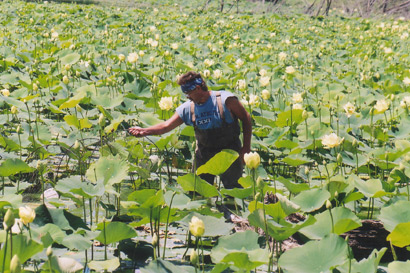 |
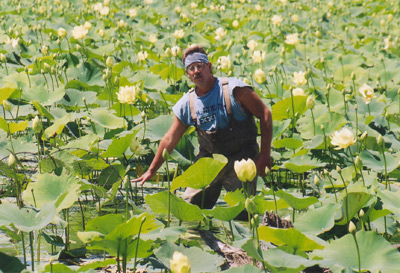 |
| In a sea of lily pads on a Dane County lake, snapping turtle hunter Rob Wegner of Lodi checks his net funnel trap. Wegner has captured 15 snappers since the season opened July 15. | |
Wegner approaches the trap, verifies one ornery inmate, and tows the net and cargo to shore of the Dane County lake. He lifts the turtle by its tail to free it from the netting, taking great care to avoid the open, hissing mouth that would take any opportunity to showcase its tremendous lockjaw capabilities on a piece of human flesh.
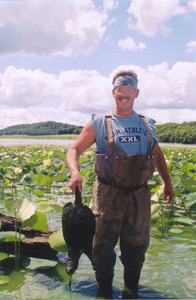 |
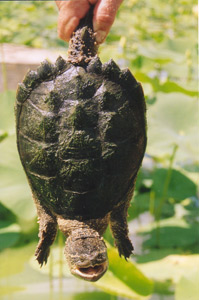 |
| Finding success in his first trap, Rob Wegner of Lodi carries a snapping turtle to the shore of a Dane County lake that has a shell measurement length within the legal slot restriction of 12 to 16 inches. The slot and season protects the turtle population, egg-bearing females, and seeks to restore the mammoth snappers of yesterday. | Although well-under the minimum size limit of the 12 to 16 inch shell length slot, this smaller snapping turtle captured by Rob Wegner displays the disposition of any captured snapper. Snappers begin laying eggs when they are between eight and nine inches in length. The slot protects smaller turtles from harvest until they have had several years of reproductive potential. |
“I’ve never been bit and I don’t plan to be,” says Wegner, butcher and meat department manager at the D&D PigglyWiggly in Lodi and life member of the Wisconsin Trappers Association (WTA). “I still remember the warning from an old timer on the Mississippi down near Bagley who was missing his thumb and finger.”
The snapper is placed on the ground and its shell measured. If the shell length fits within the legal slot of 12 to 16 inches, it may be kept. If under or over, the turtle will be immediately set free. This snapper is a “keeper”, and placed in a traveling bag.
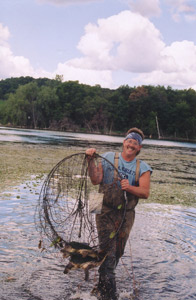 |
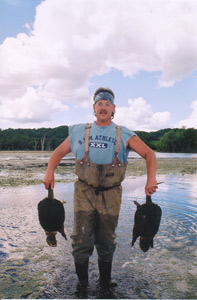 |
| Double delight. Turtle trapper Rob Wegner carries two snapping turtles captures in a net funnel trap to shore of a Dane County lake. Both turtles were under the minimum size limit of the 12 to 16 inch shell length slot, and released. | |
Wegner recalls the 30-inch shells of the mammoth snappers “that wouldn’t fit in a washtub” taken three decades ago by his father and grandfather. He longs for such a capture today, for the sheer joy of seeing it, and releasing it again to reproduce.
Not afforded the luxury of growing old and gaining bulk due to decades of intense harvest with no closed season and no license required, no bag limit, and no size limit, the largest turtles today are seemingly non-existent. In addition, natural predation including raccoons that sometimes are seen eating snapper eggs at the business end of the female turtle as soon as she lays those eggs takes a tremendous toll. To protect the snapper from over-exploitation, a Wisconsin season was adopted in 1997 that virtually transformed taking the turtles from a profitable commercial meat activity to a sporting endeavor.
According to Bob Hay, Department of Natural Resources (DNR) Cold Blooded Species Manager for the Bureau of Endangered Resources, bag and possession limits of three turtles daily and a slot size restriction found overwhelming support from the general public and the trappers themselves. The season, he said, running from July 15 through November 30, protects females during the egg-laying season. Previously, snappers had often legally been picked right off the roads attempting to lay eggs. Turtles grouped and vulnerable had also been harvested in mass during winter hibernation.
“Snapping turtle numbers are pretty stable today, meaning that if we had to take further action to protect them they would recover on their own pretty readily,” Hay said. “When you get into that situation with an endangered species, it would probably have difficulty self-recovering.”
Trappers like Rob Wegner pursue snappers for pure sport, and as a special table fare. At a 1998 trapper’s rendezvous in Cornell, he watched a how-to demonstration on turtle trapping. As a student of the game, he actively pursued the sport in 1999. Wegner is driven to know more, and through close scrutiny of his quarry, challenges commonly accepted turtle “facts”, including what food sources make up the snapper’s diet.
“I autopsy every turtle,” said the 1976 graduate of Southwest Tech in Fennimore, where he studied butchering. “90 percent of these turtles have lily pad chutes and seaweed in them, and there is very little animal matter in any snapper. I believe 99 percent of their diet is vegetarian. Occasionally, a turtle will have a fish in it.”
Since catching 33 snappers in his inaugural year of 1999, Wegner has trapped at least 15 turtles annually and as many as 42. As of July 22, he had trapped 15 turtles since the 2003 season opener a week before including four snappers with this reporter on Tuesday. Only one snapper Tuesday was large enough to keep.
When asked if his personal rate of harvest concerns him or if he remains concerned with the turtle population, Wegner said he supports the season restrictions which ensure that snappers are protected. And, through self-evaluation and strict record-keeping on his own trapping grounds, he is comfortable that the turtles are replenishing themselves adequately. Only one of every six snappers he captures is legal.
“I catch so many little ones and the following year there’s so many keepers again,” Wegner said. “I’d let the bigger ones larger than 16 inches go anyway. Those are the breeders, the snappers that make sure there’s going to be more turtles out there next year. But I do this just to be outdoors, and for the thrill of seeing what’s out here.”
“If I could ever find the snapping turtle of yesteryear, like my grandfather used to catch…to hold a 30 inch turtle that might weight 60 or 70 pounds and maybe be 150 years old…that would be awesome. Then I’d just let it go.”
OVERDUE…DECADES OF DEMISE INITIATES PROTECTION
Three primary factors prompted the adoption of new protective harvest regulations for several species of turtles in 1997, according to Bob Hay, DNR Cold Blooded Species Manager for the Bureau of Endangered Resources. One, long-time turtle trappers regularly expressed their concerns to the DNR regarding the disappearance of the big snappers. Many of those concerns focused on the over-exploitation of snappers on the Mississippi River.
“Big snappers were not as prevalent because they weren’t being allowed to live as long,” Hay said. “When the big ones are gone you’re probably over harvesting.”
Two, a state conservation warden in 1995 and 1996 came across turtle trappers on the lower Wisconsin River legally harvesting approximately 500 spiny soft shell turtles a day. The turtles were then shipped to a southern Iowa turtle farm, and marketed as a meat product primarily in the European market.
“It wasn’t illegal,” he said. “But at that rate of harvest the warden knew it was big trouble.”
And three, a turtle trapper from southwest Wisconsin contacted the DNR in 1995 after catching a 52 pound snapper in the northeast to inquire into the turtle’s age. When informed it was somewhere between 50 and 130 years old, the trapper for the first time in 32 years of turtle trapping, let a snapper go.
“He couldn’t bring himself to kill it, something had hit him right in the heart,” Hay said. “He and his father before him had exploited turtles so heavily in southwest Wisconsin he was forced to move to other parts of the state to find more turtles.”
With such concerns laying the foundation for new laws, supplemental testimony offered to the Natural Resources Board cemented the need for a turtle season. Although the state had kept no data over the decades regarding turtle populations and annual harvests according to Hay, an 82 year-old man who had commercially seined fish on the Mississippi for 75 years offered credible and riveting evidence of over-exploitation.
“He said the DNR was 40 years late in adopting a season,” Hay said. “As a commercial fisherman he had spent day after day loading train cars with turtles to send to Maryland. Trainloads of snapping turtles were shipped out because they were a nuisance to the commercial fishermen. They knocked down the snapper numbers until they weren’t a problem. That helped us move forward with the Natural Resources Board in trying to set a season and regulations that would move harvesting turtles from a commercial harvest to a sport harvest.”
In addition to summer exploitation, snappers were also being harvested in alarming numbers during winter hibernation via a “hooking” method. According to Hay, snappers hibernate by burrowing in the mud of micro-habitats such as streams with a heavy deposition of soft sediment and good water flow often near an eddy created, for example, by a fallen tree. Because the turtles congregate in these easily identifiable wintering areas, snapper hunters didn’t have to work hard for a big, and legal, payoff.
“People would use a metal prod in these hibernation areas and listen for a distinctive thud of the shell,” Hay said. “On the other end of the prod there was a small hook that would catch the bony part of the shell. The turtles would be dragged out of the mud with no harm, and because of their cold water state, with little resistance.”
Hay said 20 to 50 snappers might be harvested from a single hibernation area, and predominantly sold for meat. Prior to 1997, he said there was no season, bag limit, size restriction or other regulations to protect the turtle. For the past five years, the season has run from July 15 through November 30, with a daily bag and possession of three for snapping turtles. Only snapper shell lengths within the legal slot of 12 to 16 inches may be harvested.
“Snappers start to lay eggs when they’re between eight and nine inches,” Hay said in offering the logic behind a slot limit. “Starting the harvest at 12 inches enables three or four more years of reproductive potential. It leaves the females out there longer so they have more time to replenish themselves before being harvested.”
“The larger size of the slot wasn’t based on a scientific basis. People involved in the review process didn’t have data. They worked with the public and the turtle trappers and found tremendous support from both sides. Eighty-five percent were supportive of the 16-inch maximum limit. They wanted to see the really big turtles out there.”
The potential for great longevity and tremendous size in the Wisconsin snapping turtle and its North American cousins is intriguing, and worth protecting. Hay said that the huge Alligator Snappers of the southern states are sometimes found with musket balls or arrowheads embedded in the shell that would age the reptile at over 200 years. Wisconsin’s largest snapper’s hold that same kind of mystique.
“We caught one of those huge, old snapping turtle in a Dane County Lake,” Hay said of state survey work. “His beak was worn down to the point of being smooth. A lot of the black was gone and it had a whitish color. I knew that one had been around for a long, long time. It was neat to see it in the city of Madison.”
SNAPPER’S PHYSICAL REFLEXES UNCANNY
Turtle trapper Rob Wegner is often dumbfounded by the incredible physical reflexes of the snapping turtle and appreciates the delicious meat that his own family has chosen in the past as a main course at Easter dinner. Professional butcher Rob Wegner is perplexed by the butchering and turtle meat preparation that so-called experts recommend on outdoor cable television programming.”
“Some people say there are seven different flavors of turtle meat,” Wegner said, preparing a 12-inch snapper for butchering with a few sharp knives. “I think it all tastes like chicken. What they show on those cable programs is barbaric. You don’t need axes or chisels to butcher a snapper.”
Wegner severs the head from the turtle and allows the blood to drain. To demonstrate the first of the snapper’s many incredible physical reflexes, he takes the head to a tree where it clamps down on a branch. “That jaw will take your finger off for the next three days,” he says.
Inside his smoke house, Wegner uses a knife to enter the turtle’s underside and access the meat. He discards the unusable organs and fat. An hour later, the four chambered heart continues to beat.
“It will continue to beat for 24 hours,” he said. “I asked my doctor about it. He said if we could figure out and duplicate the reptilian heart we’d be much better off.”
As Wegner predicted, the turtle continues to move on nerve-power during the entire butchering process. Without a brain it cannot feel pain, but after five years of studying the turtle Wegner has his own ideas regarding pain and the snapper.
“I don’t think a snapper knows pain,” he said. “He knows how to inflict it.”
The job is completed as Wegner continues to answer a reporter’s questions. When his guest expresses interest in purchasing turtle meat, he offers a step-by step recipe.
Despite some reservation, four days later snapping turtle is offered with deep-fried domestic turkey for ten diners in a Boulder Junction cabin. An empty crock pot an hour later provides the unanimous verdict.
Baked snapping turtle is delicious.
